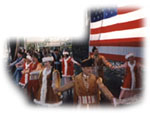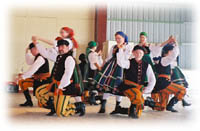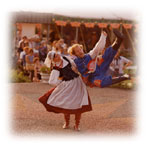National Dances
Polish dance is divided into two categories – the National Dances and the Regional Dances. National Dances are internationally known, and danced even by the nobility and royalty. Most of the National Dances originated as Regional Dances and became stylized and balletic by the nobility, who subsequently spread them throughout the country. The Regional Dances remain in styles characteristic to specific regions and are usually danced by the villagers. There are five National Dances – the Polonez, the Krakowiak, the Mazur, the Kujawiak and the Oberek – and seemingly infinite amount of regional dances.
Polonez
The oldest of the National dances is the Polonez (known as the Polonaise), dating back to the 15th century. It worked its way from a village dance called Chodzony, or walking dance, all the way to the royal court. Since then it has been the dance to open all great balls and ceremonial occasions.
Choreography by Wanda Olszewska | Back to top
Krakowiak
The city of Krakow was Poland’s second capital and now considered the cultural center of Poland. This is the origin of the Krakowiak. It is considered to be the most representative of Polish nature and character and is recognized as Poland’s national dance. The costume is considered as a worldwide symbol of Poland. The dance is characterized by a gallop sounding like a horse. The gentleman wears bells to accentuate this.
Choreography by Morley Leyton; choreography by Wanda Olszewska |
Back to top
 Mazur
Mazur
Like most national dances the Mazur originated with peasants, in this case from the Mazowsze region in east central Poland, and was embellished by the social elite into an intricate, elegant, and swift-moving dance form.
Moniuszko’s opera, “Straszny Dwór” choreography by Wanda Olszewska; “Mazur Ostatni” and “Swir Swir (chirp chirp) Mazur” See video. choreography by Morley Leyton |
Back to top
Kujawiak
The romantic Kujawiak is the most lyrical and gentle national dance, often paired with the lively Oberek. Some of the movements mimic stalks of grain swaying in the wind. The name comes from the region of Kujawy. Because of its beauty the dance became popular with the nobility who spread it throughout Poland and ranked it as a national dance.
“Kujawiak z Oberkiem” choreography by Leokadia Magdziarz; “Kujawiak z Oberkiem” choreography by Morley Leyton |
Back to top
 Oberek
Oberek
The fiery, acrobatic dance with lots of stamps, shouts, jumps and twirls, often paired with the gentle Kujawiak. Like the Mazur, it originated from the Mazowsze region but it is the only one of the five National Dances to maintain its peasant integrity. It was spread only in the late 19th century.
“Kujawiak z Oberkiem” choreography by Leokadia Magdziarz; “Kujawiak z Oberkiem” choreography by Morley Leyton; “Oberek Opoczynski” choreography by Mazowsze with Morley Leyton; “Maciek Oberek” including “Wesoly Wacus” choreography by Morley Leyton |
Back to top
Home | About Us | Repertoire | History | Join Us | Contact Us | Links | News
Copyright © 2017, Janosik Polish Dance Ensemble